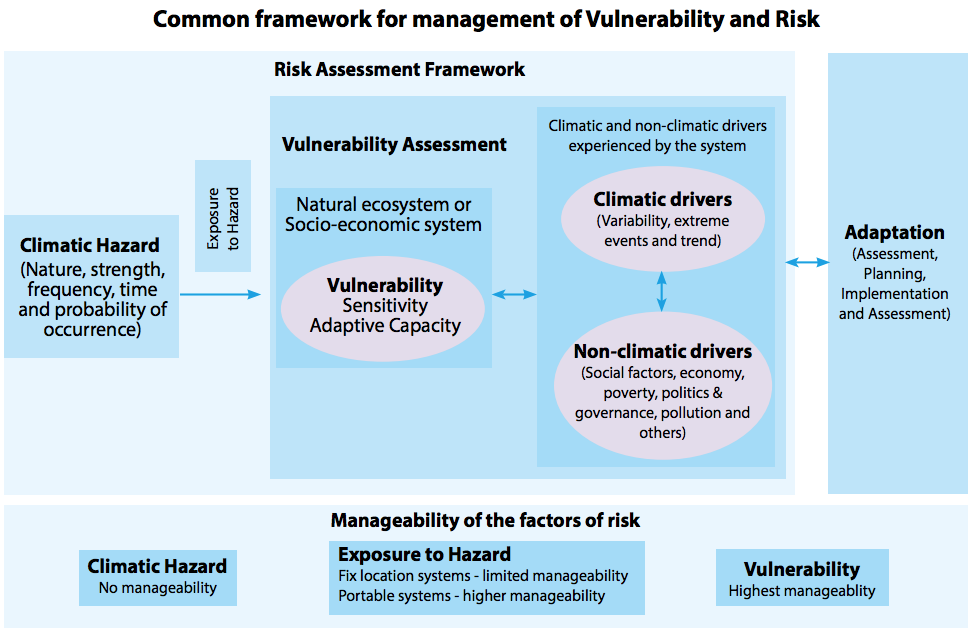Climate Vulnerability and Risk Assessment for the Indian Himalayan Region

Introduction
The Indian Himalayan Region (IHR) is highly vulnerable to climate change owing to its fragile ecosystem and high dependence of communities on natural resources. Climate change poses unprecedented challenges for multiple sectors and socio-economic development in the region. Climate change is introducing uncertainties which hamper the achievement of the objectives of development policies and plans.
To reduce these uncertainties and plan towards sustainable development it is essential to adopt evidence based adaptation planning in IHR. This requires an in-depth understanding of the key risks and vulnerabilities derived from scientific assessments. While some Indian Himalayan States have carried out vulnerability assessments within their states there has been no study done at regional level yet. Also, there has been no consistency in terms of the framework used for vulnerability assessments done within the states. The multiplicity of challenges in IHR calls for the need of a coordinated and integrated approach for adaptation planning. Having a common framework for vulnerability and risk assessment can contribute towards this objective.
A Manual for Climate Vulnerability and Risk Assessment
Understanding the need of an integrated approach towards adaptation the Indian Himalayas Climate Adaptation Programme (IHCAP) supported the development of a common framework for climate vulnerability and risk assessment for IHR. The framework, developed by the Indian Institute of Science, Bangalore with support from the Himalayan States, is based on the latest IPCC AR5 framework for risk assessment. This common framework for assessment and reduction of common vulnerability and risk in the context of climate change highlights the manageability of the factors leading to risk. System vulnerability has the highest manageability among the three components of risk, especially for IHR. Vulnerability assessment thus becomes pivotal for adaptation planning in the region.
This manual*describes the common framework for climate vulnerability and risk assessment. It is organised into three parts:
- Part 1: Climate Change Vulnerability and Risk Assessment Framework
- Part 2: Climate Change Vulnerability and Risk Assessment Methods and Guidelines
- Part 3: Integration of Climate Change Vulnerability and Risk Assessment into Adaptation Planning
The focus of this Manual is to provide practical guidance on assessment and estimation of current climate vulnerability of regions, sectors and communities. It is aimed at practitioners involved in development, implementation and monitoring of climate change vulnerability reduction and adaptation programmes. Though the framework has been presently applied to the Himalayan region it may be applied to the other regions of India as well.
Read the results from the application of this framework.
*Download available from the right-hand column.
Rationale for Vulnerability Assessment
Vulnerability assessment is required for multiple purposes, particularly for adaptation planning. Vulnerability assessment would assist in:
- Adaptation planning of developmental programmes and projects.
- Prioritisation of adaptation interventions and investment at national, state, district and village levels.
- Developing adaptation proposals for Green Climate Fund, World Bank, Asian Development Bank, Adaptation Fund, bilateral agencies, etc.
- Meeting the requirements of Paris Agreement, Article 9 that requires assessment of the impact and vulnerability.
- Designing and implementing the ‘Nationally Determined Contributions’ component which aims to better adapt to climate change by enhancing investments in development programmes in sectors vulnerable to climate change.
- Revision of the State Action Plan on Climate Change for assessing the vulnerability and prioritising adaptation programmes and projects.
Contributing towards the NMSHE
The development of this manual on ‘Climate Vulnerability and Risk Assessment’ has been supported by Indian Himalayas Climate Adaptation Programme (IHCAP), a project of the Swiss Agency for Development and Cooperation (SDC). IHCAP is being implemented as a bilateral cooperation programme with the Department of Science and Technology (DST), Government of India. IHCAP has been supporting the implementation of the National Mission for Sustaining the Himalayan Ecosystem (NMSHE)as a knowledge and technical partner. The development of the common framework for vulnerability and risk assessment contributes towards the objectives of NMSHE and lays a foundation for a coordinated and integrated approach for adaptation in the Indian Himalayan Region.
Authors:
Jagmohan Sharma, Indu K Murthy, T Esteves, Payal Negi, Sushma S, Shyamasree Dasgupta, Anamika Barua, G Bala and N H Ravindranath
Suggested Citation:
Sharma J, Indu K Murthy, Esteves, T., Negi. P., Sushma S, Dasgupta S., Barua A., Bala G and Ravindranath N H., 2018. Vulnerability and Risk Assessment: Framework, Methods and Guideline, Indian Institute of Science.
This report is available in the electronic form at: http://www.ihcap.in/resources.html
Related resources
- Read more about the Indian Himalayas Climate Adaptation Programme
- Read more about Assessing climate vulnerability and risk in the Indian Himalayan Region
- Read about Flood risk and Early Warning Systems in the Indian Himalayan Region
- Read about Mountain and lowland linkages: A Climate Change perspective in the Himalayas
- Read about Ecosystem based Adaptation: An integrated response to climate change in the Indian Himalayan Region
- Go to the Himalayas Climate Change Portal
(0) Comments
There is no content